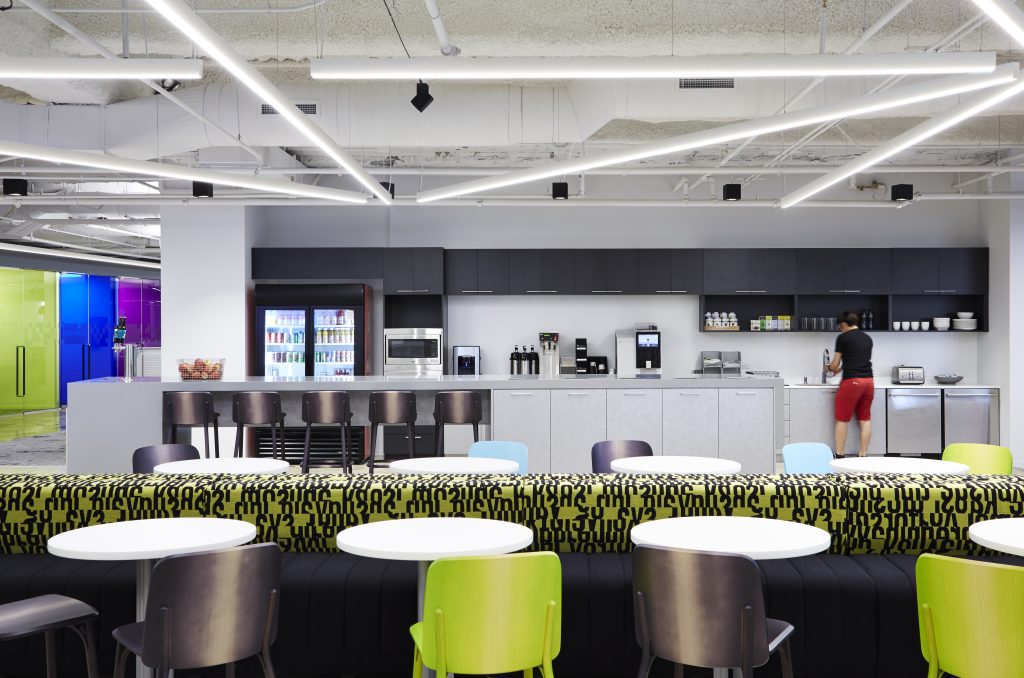What is the right light? A primer for architects

The “right” light—it’s what everyone wants, but what is it?
The right light for a space is light that delivers in three areas: the right amount of light at the right location for the right amount of time. Just as “one-size-fits-all” clothing really fits no one, the right light for one project will be different for another. It depends on the purpose of the space, it’s shape and design and environmental factors (e.g. if there are windows, then there’s fickle daylight to consider).
While the right light will vary from project to project, there are some guiding principles that can help you hit the target each time.
The Right Amount of Light
Many commercial spaces—especially offices—are over-illuminated. Too much light wastes energy, uses more fixtures than necessary and creates an uncomfortable environment for people to work in. Office lighting issues routinely come up on employee satisfaction surveys. Both over- and under-illumination cause eye-strain and headaches, although of the two, over-illumination is far more common.
How much light you’ll need to incorporate into a space depends on what the room’s function and demographics of the likely users.
Younger people need less light than older people and paper-based work also requires more light than computer screen-based work. According to the IES Lighting Handbook, the average 20-year-old needs 30 footcandles to comfortably read 10-point type. This doubles to 60 footcandles for the average 50-year-old.
For example, a team of young software engineers will require far less light than a group of middle-aged employees who deal mostly with paperwork.
-
The light you see versus the light that’s there
Besides actual amounts of light, there is also the perception of light to manage. Lumens are measured, while brightness is perceived—meaning it’s subjective. A variety of factors influence whether a room feels bright to us—including the color-temperature of the light, the color of the walls and ceiling, contrast levels and whether or not there is glare.
-
Avoiding glare
Glare is a major hindrance when it comes to delivering the right amount of light (both real and perceived) because it is very aggressive on our eyes. Lighting designers are very careful to avoid glare. They are looking for a “quiet ceiling,” says Carlos Alonso-Niemeyer, principal at Reflex Lighting in Boston. “Meaning the ceiling doesn’t have areas that are bothering your eyes. A quiet ceiling is a uniform space without sparkles or glare, since glare produces a lot of discomfort for users.”

Light in the Right Location
Lighting should achieve three things in a room: it should provide a minimum level of general illumination so people can see where they are walking, it should facilitate accomplishment of whatever task the space is designed for and it should set the mood for the space.
In most cases, the best way to achieve all three of those things is to spread out the light fixtures and illuminate the room in different layers. Lighting in layers—instead of filling the ceiling with downlights or standard 2×4 troffers—spreads the illumination burden out. If a space is only illuminated by ceiling-mounted downlights, then those lights must work harder at lighting everything appropriately, and glare is inevitable.
-
Light in layers
Instead, start with task lighting to facilitate the space’s main purpose—this could be desk lights for an office, step lights for staircase and so on. Then add fixtures to raise the ambient light levels as needed. Finally, accent lighting will highlight the architecture of the space. (What does lighting in layers look like in real life? Here are four case study examples)
-
Leave the lighthouses for ships
Lighting in layers ensures there’s always adequate light for tasks and it avoids situations where you have a “lighthouse” lamp in the corner of a room trying to illuminate a facing wall or cast light across the room. Lighthouses are important for ships, but a lamp that has to work like a lighthouse in a room is a recipe for glare and uneven lighting. The dark corners that come from “lighthouse” lighting makes the whole room look darker and less inviting.
Light for the Right Amount of Time
If you watch a time-lapse video, it’s easy to think that the space is static, while the action goes on inside it. However, good spaces—like most things on earth—are actually dynamic. There’s a natural ebb and flow in nature (even trees “sleep” at night) and infrastructure and architecture should mirror that dynamism for the health of the people who use it.
The amount and type of light we need varies over the day. We evolved under the sun and our sleep/wake cycle follows its rising and setting. Known as human-centric lighting, electric light that mimics the sun’s cycle helps us maintain healthy circadian rhythms. This is achieved through sensors and controls which will dim the lights to complement any natural light present as well as follow a bright/dim cycle during the day.
Blue light is a powerful tool for stimulating alertness and cognitive function—which is exactly what we need in the morning, while evening exposure to blue light is a good way to interrupt your sleep. Today’s LED lights and control systems make it easy to deliver electric light that emulates natural sunlight for a healthy work environment.
Different projects require different amounts of light, which is why it’s important for individual controls on task lighting, so users can dim or raise their lights as needed.
Be seen in the best light—the right amount light, in the right location, for right amount of time—with Amerlux’s innovative lighting solutions. Schedule your free consultation today.

